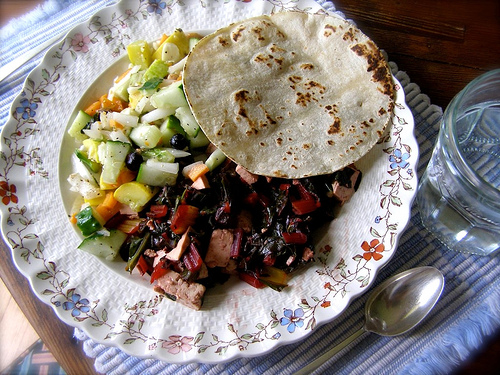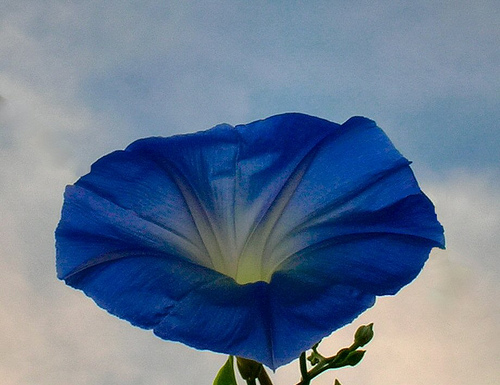Check out these what china imports images:
Veg High

Image by mystuart
Between receiving a CSA (farm) box of chemical-free vegetables each week and trying to maintain a high-vegetable-consumption diet (at least 5 per day, ditto fruits), meal preparation can be unusual!
The greenish salad is cucumber, carrot, cabbage, clove garlic, onion, cooked squash, lettuce-y greens, various herbs, olive oil, vinegar, lemon juice. The reddish cooked dish is multi-colored chard (I prefer the green/white kind, but "rainbow" is what I get) and chunks of bean curd/tofu flavored before with soy sauce, hot sauce, vinegar and honey. Eaten with a hot corn tortilla in the hand (as a pusher or a wrap) it was quite good!
The china is "Wicker Dale" by Copeland/Spode. I have only two plates and a small serving bowl in the pattern. They belonged to my aunt–she had a large set from, I think, the 1930s. I know they are post 1891, for that is when the law was passed in the US requiring country of origin to be shown on imports, and these are marked "England".
Here’s a bit about Spode.
www.kovels.com/price-guide/pottery-porcelain-price-guide/…
EXPLORED!! Thanks for looking, friends!
如上以下 As above, so below / 香港沙田城門河 之寧 Hong Kong Shatin Shing Mun River Serenity (HDR Timelapse) / SML.20130807.6D.25087-SML.20130807.6D.25677-HDR-PPTM-TL

Image by See-ming Lee 李思明 SML
This is an HDR time-lapse of a Shing Mun River (城門河) during sunset in Hong Kong. It was shot from the vantage point of the Banyan Bridge (翠榕橋) which runs parallel to the river which reaches most of Shatin (沙田).
# Black and white vs Color
The video first shows what the HDR footage looks like in color, which highlights the change in hues during sunset. Then it shows a side-by-side comparison when processed in black and white. And finally, it shows the footage when separately processed in black and white. In the B+W rendition, you would see that the intention — which is the clouds in the sky and its reflection from the river — is much more pronounced when the color information is removed.
# Workflow
As I wrote previously [1], I originally had not intended it to be an HDR time-lapse, but since I erroneously left the AEB (auto-exposure bracketing) on before starting the timer, I ended up with 3 exposures spanning -3 to +3 every 5 seconds. The way I processed it is as such:
1. Import RAW files into Lightroom, such that they would be serialised (renamed) the way I need them to.
2. Create an HDR processing preset using Photomatix Pro using one of the image stack.
3. Batch-process the whole folder of images using the preset set in step 2 and output to 16-bit TIF and 32-bit HDR files.
4. Import those 16-bit TIFs into Lightroom, and create DNGs for each of the tone mapped HDR images.
5. In LRTimelapse, setup keyframes from the DNGs (LRT only works on DNG or CR2 and not TIFs)
6. Processed keyframes in Lightroom: one set for color, one set for B+W)
7. Batch-process DNGs using LRT again.
8. Export 1080p JPGs from Lightroom for each frame.
9. Assembled image sequences inside After Effects.
The workflow is not really very complex — but mostly I was just waiting for the computer to crunch numbers to process all these images. After all this, you get 8 seconds of footage, which was also one of the reasons why I decided to output both the color and black and white versions so there would be a slightly longer time to watch it through.
# Soundtrack: Memoirs (Cinematic Version) by Rameses B
Once again, I salute talented musicians who graciously published their music under Creative Commons (CCBY) such that I can focus on working on the visuals. Soundtrack has always been the bottleneck for most of my footage.
soundcloud.com/ramesesb/rameses-b-memoirs-cinematic
# Notes
1. 如上以下 As above, so below / 香港沙田城門河之寧 Hong Kong Shatin Shing Mun River Serenity (BW HDR) / SML.20130807.6D.25123-24-25.HDR.BW: www.flickr.com/photos/seeminglee/9501334606/
# SML Data
+ Date: 2013-08-07 (recorded) 2013-08-14 (processed)
+ Camera: Canon EOS 6D
+ Lens: Canon EF 17-40 f/4L USM
+ Accessories: Canon TC-80N3, Manfrotto tripod, Manfrotto head
+ Workflow: Lightroom 5, LRTimelapse 3, Photomatix Pro 4, After Effects CC, Ableton Live Suite 8
+ Video: 1920×1080 (1080p), 24fps, Progressive
+ Location: 香港沙田城門河 Shing Mun River, Shatin, Hong Kong
+ Photographer: See-ming Lee 李思明 / SML Photography
+ Soundtrack: Rameses B: Memoirs (Cinematic Version) / SoundCloud CCBY
+ Media Production: SML Universe
+ License: Creative Commons Attribution 3.0 Unported (CCBY)
+ Copyright: 2013 See-ming Lee 李思明 / SML Universe Limited
+ Series: 寧 Serenity
+ Serial: SML.20130807.6D.25087-SML.20130807.6D.25677-HDR-PPTM-TL
# SML Simulcast
+ flickr.com/photos/seeminglee/9510440760/
+ vimeo.com/72341934
+ youtube.com/watch?v=FZXN8jMyDQo
# Media Licensing
Creative Commons (CCBY) See-ming Lee 李思明 / SML Photography / SML Universe Limited
如上以下 As above, so below / 香港沙田城門河
之寧 Hong Kong Shatin Shing Mun River Serenity (HDR Timelapse) / SML.20130807.6D.25087-SML.20130807.6D.25677-HDR-PPTM-TL
/ #寧 #Serenity #SMLSerenity #HDR #SMLHDR #Timelapse #CreativeCommons #CCBY #SMLPhotography #SMLUniverse #SMLProjects
/ #中國 #中国 #China #香港 #HongKong #攝影 #摄影 #photography #山水 #landscape #自然 #Nature #cloudscape #clouds #video
Glory-ous morning

Image by Mona Loldwoman (Look for the good)
A slightly different look at Morning Glories , Did you know they are…(SAY WHAT?????)
BOTANICAL CLASSIFICATION
Family :Convolvulaceae
Genus :Ipomoea
Species :violacea L. (or tricolor Cav.)
COMMON NAMESMorning Glory; Heavenly Blue Morning Glory; Tlilitzin; Badoh Negro (seeds)
EFFECTS CLASSIFICATIONPsychedelicDESCRIPTION
Ipomoea violacea is a common ornamental vine with heart-shaped leaves and bright white, pink, blue or purple flowers and small, black seeds that contain LSA. Because of its fast growth and prodigious seed production, many jurisdictions consider it an invasive weed plant. It has a long history of use in Central to Southern Mexico.
www.erowid.org/plants/morning_glory/morning_glory.shtml
**************************
Morning GloryTimeline
by Erowid
16th Century Xochipilli statue carved. Aztec statue depicts the Prince of Flowers decorated with 6 psychoactive plants: mushrooms, tobacco, morning glory, sinicuichi, cacahuaxochitl, and one unidentified.
Mid 1800s Xochipilli statue discovered by Europeans in central Mexico.
1968-1969 Both Argyreia nervosa (Hawaiian Baby Woodrose) and Ipomoeia violacea (Morning Glory) seeds are distributed and used recreationally in the U.S.
References
Bureau of Narcotics and Dangerous Drugs. Microgram. Sep 1968;1(10).
www.erowid.org/plants/morning_glory/morning_glory_timelin…
********************************************************************************
Morning glory is a common name for over 1,000 species of flowering plants in the family Convolvulaceae, whose current taxonomy and systematics is in flux. Morning glory species belong to many genera, some of which being:
Calystegia, Convolvulus, Ipomoea, Merremia, Rivea, Astripomoea, Operculina, Stictocardia, Argyreia, Lepistemon
HABIT
The flower usually lasts for a single morning and dies in the afternoon. On a cloudy day, the flower may last until night. New flowers bloom each day. The flowers usually start to fade a couple of hours before the petals start showing visible curling. They prefer full sun throughout the day and mesic soils. Some morning glories, such as Ipomoea muricata, are night blooming flowers.
In some places such as Australian bushland, morning glories develop thick roots and tend to grow in dense thickets. They can quickly spread by way of long creeping stems. By crowding out, blanketing and smothering other plants, morning glory has turned into a serious invasive weed problem.
CULTIVATION
In cultivation, most are treated as perennial plants in frost-free areas and as annual plants in colder climates, but some species tolerate winter cold. There are some species which are strictly annual (eg. I. nil), producing many seeds, and some perennial species (eg. I. indica) which are propagated by cuttings. Some moonflowers, which flower at night, are also in the morning glory family.
Because of their fast growth, twining habit, attractive flowers, and tolerance for poor, dry soils, some morning glories are excellent vines for creating summer shade on building walls when trellised, thus keeping the building cooler and reducing heating and cooling costs.
Popular varieties in contemporary western cultivation include ‘Sunspots’, ‘Heavenly Blue’, the moonflower, the cypress vine, and the cardinal climber. The cypress vine is a hybrid, with the cardinal climber as one parent.
HISTORY
Morning glory was first known in China for its medicinal uses, due to the laxative properties of its seeds.
It was introduced to the Japanese in the 9th century, and they were first to cultivate it as an ornament. A rare brownish-coloured variant known as Danjuro is very popular. During the Edo Period, it became a very popular ornamental flower.
Ancient Mesoamerican civilizations used the morning glory species Ipomoea alba to convert the latex from the Castilla elastica tree[citation needed] and also the guayule plant to produce bouncing rubber balls[citation needed]. The sulfur in the morning glory’s juice served to vulcanize the rubber, a process pre-dating Charles Goodyear’s discovery by at least 3,000 years.
[1] Aztec priests in Mexico were also known to use the plant’s hallucinogenic properties. (see Rivea corymbosa)..
CULINARY USES
Ipomoea aquatica, known as water spinach[citation needed], water morning-glory, water convolvulus, Ong-Choy, Kang-kung, or swamp cabbage, is popularly used as a green vegetable especially in East and Southeast Asian cuisines. It is a Federal Noxious Weed, however, and technically it is illegal to grow, import, possess, or sell within the USA. See: USDA weed factsheet. As of 2005, the state of Texas has acknowledged that water spinach is a highly prized vegetable in many cultures and has allowed water spinach to be grown for personal consumption. This is in part because water spinach is known to have been grown in Texas for more than fifteen years and has not yet escaped cultivation.[2] The fact that it goes by so many names means that it easily slips through import inspections, and it is often available in Asian or specialty produce markets
ETHNOBOTANY
Main article: Ergine
The seeds of many species of morning glory contain ergot alkaloids such as the hallucinogenic ergonovine and ergine (LSA). Seeds of I. tricolor and T. corymbosa (syn. R. corymbosa) are used as psychedelics. The seeds can produce a similar effect to LSD when taken in the hundreds. Though the chemical LSA is illegal to possess in pure form, the seeds are found in many gardening stores; however, the seeds from commercial sources are often coated in some form of pesticide or methylmercury to retard spoilage [3] – these coatings are especially dangerous if you have a history of liver disorders and may also cause neurological damage. [4][5][6] Also, the active ingredient LSA has, in animal models, produced uterine contractions, which could possibly induce a miscarriage.[7]
WIKIPEDIA
en.wikipedia.org/wiki/Morning_glory#History
*********************************************************************************
WOE,….And I just went looking for the History of the plant in relation to archeology.
Did I EVER learn something today !
DSCN5899